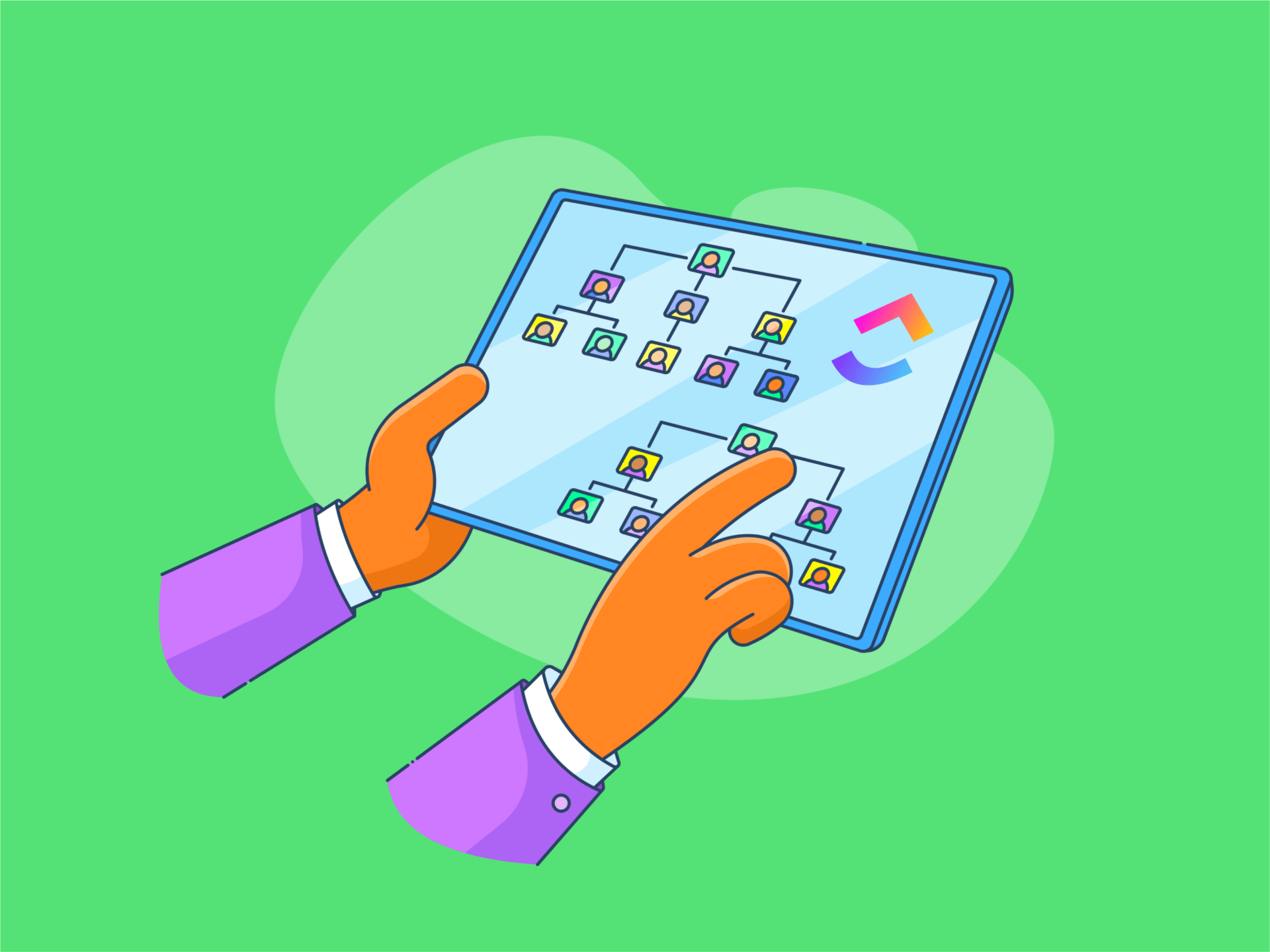اليوم، عندما يكون أكثر من الربع من الموظفين العالميين يرغبون في ترك وظائفهم الحالية، فإن الاحتفاظ بالموظفين أصبح أكثر أهمية من أي وقت مضى. أصحاب العمل الذين لا يعطون الأولوية للاحتفاظ بالمواهب سيجدون أنفسهم يعانون.
فالاحتفاظ الناجح بالمواهب لم يعد يتعلق فقط بالرواتب. فهو يتطلب من المؤسسات أن توفر للموظفين ثقافة شركة رائعة، وتلبية احتياجاتهم العاطفية، وتقديم الدعم لتحقيق أهدافهم المهنية.
استخدم هذا الدليل المتطور لإدارة الموارد البشرية لفهم كيفية الاحتفاظ بالموظفين ذوي المواهب المتميزة اليوم.
ملخص
- يعتمد الاحتفاظ بالموظفين على أساليب التوظيف وإدارة المواهب لديك
- يمكن أن يساعد التأهيل والتدريب الشاملين في تحسين معدلات الاحتفاظ بالموظفين
- هناك ثمان استراتيجيات للاحتفاظ بالموظفين ذوي المواهب المتميزة:
- تحفيزهم وتقديرهم ومكافأتهم
- توفير فرص التطوير الوظيفي
- التأكيد على ترتيبات العمل المرنة
- بناء ثقافة شاملة وداعمة ومحترمة في العمل
- تحسين مع التغذية الراجعة
- إظهار التعاطف
- مكافحة أسباب دوران الموظفين
- استخدام التكنولوجيا والذكاء الاصطناعي لتحسين العمليات وتسريعها
ما هو الاحتفاظ بالموظفين؟
ببساطة، الاحتفاظ بالموظفين هو قدرة مؤسستك على الاحتفاظ بموظفيها. ويتطلب استخدام استراتيجيات الاحتفاظ بالموظفين للحفاظ على الموظفين الموهوبين والمنتجين داخل المؤسسة. ينصب التركيز على بناء ثقافة عمل إيجابية لتقليل معدل دوران الموظفين. ومع ذلك، لا يمكن النظر إلى الاحتفاظ بالموظفين بمعزل عن الآخرين. تعتمد كيفية الاحتفاظ بالموهبة على:
- استراتيجية التوظيف الخاصة بك
- الطريقة التي تقود بها إدارة المواهب ورضا الموظفين
دعنا نفهم كيف أن تحسين أحد المجالات له تأثير تدريجي على المجالات الأخرى.
1. ابدأ باستراتيجية التوظيف الخاصة بك
تبدأ إدارة المواهب قبل أن ينضم الموظف إلى الشركة بوقت طويل؛ فهي تبدأ باستراتيجية التوظيف الخاصة بك:
- هل يجد المرشحون المحتملون عملية تقديم الطلبات سريعة وسهلة وسلسة؟
- هل يرى المرشحون أن عملية الفرز عادلة ومحترمة وموضوعية؟
- هل تقوم بإجراء مقابلات مع المرشحين بشكل شامل، بما في ذلك المهارات الأساسية والشخصية؟
- هل تضع عملية الفرز الخاصة بك مصالح المرشح في المقدمة؟
لا يمكنك جذب المواهب عالية الجودة إلا من خلال كسب ثقة المرشح منذ اليوم الأول واستخدام استراتيجية التوظيف الخاصة بك لإظهار اهتمامك بهم.
نصيحة للمحترفين: استخدم أدوات الذكاء الاصطناعي في _ClickUp Brain لكتابة توصيف الوظائف، وإنشاء أسئلة مناسبة للمقابلات، تلخيص الملاحظات من المقابلات، وإنشاء بنك من رسائل البريد الإلكتروني لجميع مراحل دورة التوظيف_
2. تعزيز النوايا الحسنة من خلال جهود إدارة المواهب الخاصة بك
بمجرد دخول الموظف إلى مؤسستك، فقد حان الوقت للتركيز على مبادرات إدارة المواهب الخاصة بك - وهو أحد أهم المتطلبات الأساسية للاحتفاظ بالموظفين.
المنظمات التي يشعر فيها الموظفون بالرضا الشديد عن مديريهم تقرير :_
- 72% انخفاض بنسبة 72% في الاستنزاف
- 3.2 مرة زيادة في تحفيز الموظفين
- 13.9 مرة زيادة في الرضا الوظيفي
يحصل العمل على استراتيجية إدارة المواهب الخاصة بك على استحسان كبير من الموظفين. ولكن ماذا نعني بإدارة المواهب؟
إدارة المواهب هي العملية الاستراتيجية لتوظيف المواهب وتطويرها والاحتفاظ بها وتحسينها داخل المؤسسة لتحقيق أهداف أعمالها الحالية والمستقبلية. وهي تشمل أنشطة رئيسية مثل التوظيف، والتدريب والتطوير، والتأهيل، وتخطيط التعاقب الوظيفي، وإدارة الأداء، وما إلى ذلك.
## أثر التوظيف الفعال في الاحتفاظ بأفضل المواهب
دعنا نرى كيف ترتبط إدارة المواهب بتوظيف الموظفين بالطريقة الصحيحة. إن مشهد التوظيف ليس سهلاً بالنسبة لأصحاب العمل، بالنظر إلى أن متوسط التكلفة لكل موظف يصل إلى آلاف الدولارات. يمكن للتجربة السيئة مع المؤسسة في أي خطوة من خطواتها أن تدفع المواهب الأفضل أداءً إلى الخروج من الباب، تاركين كل الجهد المبذول في توظيفهم يضيع هباءً.
ولتفادي هذا الخطأ المكلف، من الضروري إعادة وضع تصور جديد لاستراتيجية التوظيف الخاصة بك، وصقل مهارات موظفيك، وتحديد المرشحين الذين سيستمرون في العمل.
إليك بعض النصائح:
- الوصف الوظيفي: قم بتقييم المهارات اللازمة للوظيفة وأعد كتابة الوصف الوظيفي لتحديد التوقعات الصحيحة
- ملاءمة الثقافة: قيّم الجوانب الثقافية للمؤسسة وقيّم مدى ملاءمة المرشح للوظيفة لمعرفة ما إذا كان يتشارك نفس القيم والمعتقدات والأهداف الأساسية
- المهارات الشاملة: ابحث عن مرشحين يتمتعون بما لا يقل عن 70 إلى 80% من المهارات الأساسية المطلوبة لوظيفة معينة. ابحث أيضًا عن الاهتمامات خارج العمل، مثل العمل التطوعي، وممارسة رياضة جماعية، وما إلى ذلك.
- اختبر: قم بتعزيز التدريب الداخلي المصغر حيث يمكن للمرشحين تقييم مدى ملاءمتهم داخل المؤسسة
- مجموعة المواهب: وسّع نطاق بحثك واستفد من قواعد الموظفين المخفية، بما في ذلك المتقاعدين والأمهات حديثي الولادة اللاتي يتطلعن إلى الانضمام إلى القوى العاملة.
- الاهتمام: قم بتقييم مدى اهتمام المرشح بالانضمام إلى شركتك. عادةً ما يبحث المرشحون المهتمون عن العلامة التجارية، ويطرحون الأسئلة، ويظهرون الحماس.
كيف يؤدي التأهيل والتدريب إلى تحسين الاحتفاظ بالموظفين
يشهد معظم أصحاب العمل تحسنًا في الاحتفاظ بالموظفين من خلال عملية تأهيل قوية ومنظمة.
يعزز التأهيل المناسب الاحتفاظ بالموظفين، ويحسن إنتاجية الموظفين، ويحفز المشاركة. فالموظفون الذين يشعرون بشعور أكبر بالانتماء إلى فريق العمل يصبحون أصولاً حيوية للشركة.
وإليك الأسباب التي تجعل عملية التأهيل والتدريب أمرًا أساسيًا لجهود الاحتفاظ بالموظفين:
يجعل الموظفين أكثر سعادة وإلمامًا
_تقريباً ثلث الموظفين الجدد سيتركون الشركة خلال أول 90 يوماً بسبب سوء تجربة التأهيل
يمكن مواجهة هذا الأمر من خلال التدريب على التأهيل، والذي يتضمن تعريف الموظفين الجدد بقيم الشركة وثقافتها وسياساتها ومرافقها وموظفيها.
يساعد الموظفين على فهم توقعات المؤسسة
يشجع برنامج التأهيل والتدريب الموظفين على المشاركة في الأنشطة الرئيسية وفهم أدوارهم الوظيفية ومسؤولياتهم وتوقعات صاحب العمل بشكل أفضل. يمكنهم الوصول إلى المواد التدريبية ذات الصلة مثل الأدلة، والمقالات الإرشادية، ومقاطع الفيديو الخاصة بالشركة، والأسئلة الشائعة، وما إلى ذلك، والنجاح في دورهم الجديد.
تحسين معنويات الموظفين ورضاهم الوظيفي
ترتفع إنتاجية الموظفين ومعنوياتهم بشكل كبير مع استمرار تدريبهم على الاتجاهات المستجدة ومجموعات المهارات وعمليات الشركة. يسمح تدريب الموظفين أثناء تأهيلهم بتعزيز أدائهم وتحقيق أهداف المؤسسة أو تجاوزها في وقت مبكر من دورة حياة الموظف.
يمكن الموظفين من الاندماج بشكل جيد في الفريق
الموظفون الذين يتناسبون مع الدور الوظيفي ويندمجون مع الفريق منذ اليوم الأول يمكنهم العمل بثقة ووضوح أكبر. بالإضافة إلى ذلك، يتيح التأهيل المهني للموظفين مساحة لطرح الأسئلة، وتعلم كيفية الأداء في وظائفهم، وإزالة سوء الفهم على طول الطريق. من ناحية أخرى، تستفيد المؤسسة من المواد التدريبية لإيصال توقعاتها من الموظف والبدء في العمل.
تقود تجربة تعليمية تفاعلية للموظفين
إن استكمال عملية التأهيل بالتدريب أثناء العمل، مثل الندوات عبر الإنترنت وورش العمل وما إلى ذلك، يحسّن من فعالية الموظفين بسبب تجربة التعلم التفاعلية والتعاونية. يقضي الموظفون الوقت في اكتساب مهارات جديدة والتواصل مع الفريق على مستوى أعمق.
لذا، فإن السؤال الحقيقي هو: كيف يمكنك بناء عملية تدريب سلسة أثناء التأهيل للموظفين الجدد لديك؟
تتطلب هذه العملية ذات الشقين
- تقييم شامل لنقاط قوة موظفيك وعوامل الخطر والدوافع الخاصة بهم حتى تتمكن من إنشاء فرص تدريب مخصصة
- زيادة التركيز على تحسين تجربة التأهيل لموظفيك عن بُعد - الذين من المحتمل أن يشعروا بأنهم غير مدربين أكثر من الموظفين في الموقع
- تبسيط عملية تقديم الطلبات من خلال تدفقات عمل وعمليات مدروسة
- التركيز بشكل أكبر على تطوير الموظفين وتدريبهم ونموهم
- تعزيز التوجيه والدعم للموظفين الجدد من خلال نظام الأصدقاء، وقواعد المعرفة، ومقاطع الفيديو، والدروس التعليمية، والوثائق، وبرامج الإرشاد الفردي، وما إلى ذلك.
- إجراء مراجعات منتظمة مع الموظف الجديد وإعادة تأهيل الموظف إذا لزم الأمر
- تنظيمأنشطة مشاركة الموظفين لكسر الجليد وإشراك الفريق:
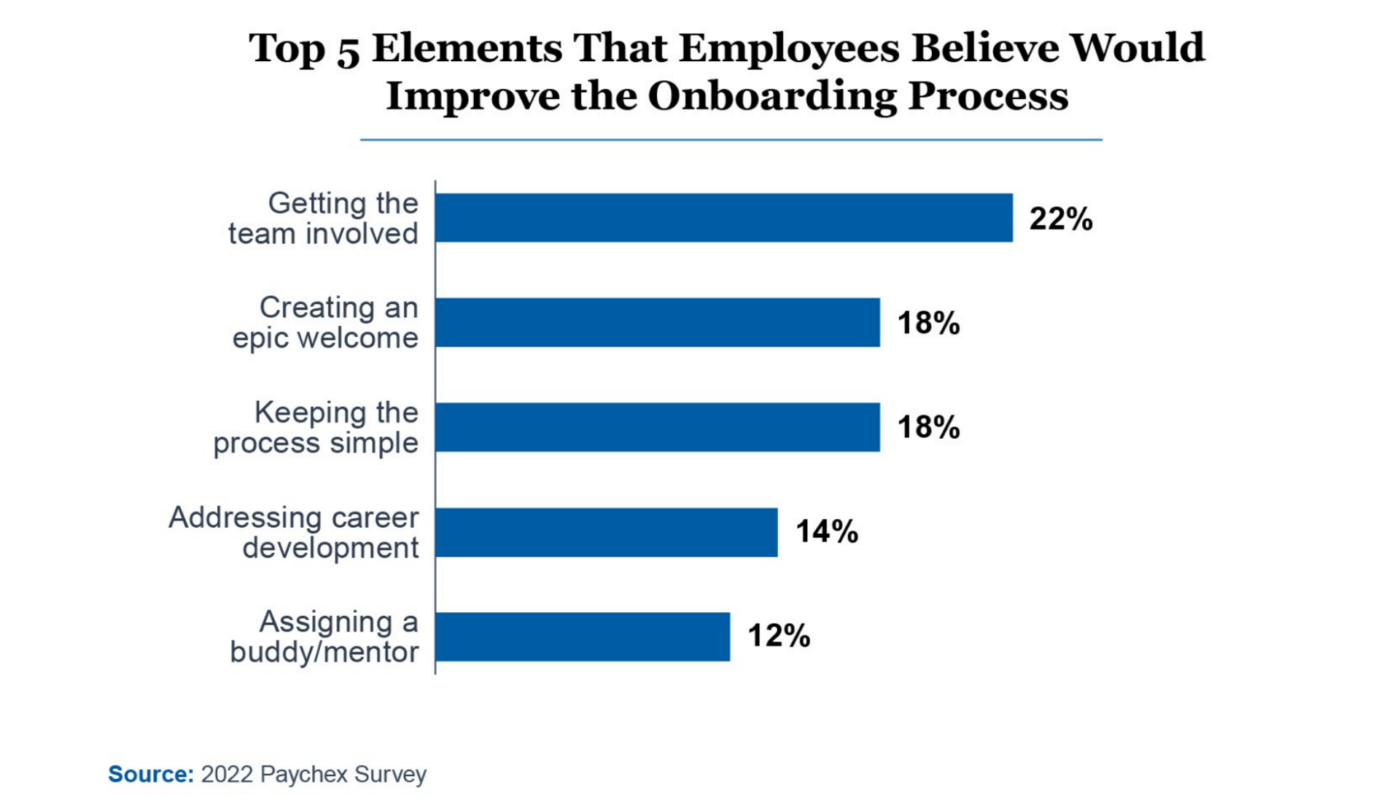
_22% من الموظفين يشعرون بأن إشراك الفريق سيحسن من تجربة التأهيل عبر
_ / href/ _https://www.paychex.com/articles/human-resources/the-onboarding-crisis Paychex /%_href/
لكن المشكلة تكمن في العمل على إعداد استراتيجية التأهيل. فبدون الأدوات المناسبة، قد يصبح الأمر مملاً للغاية.
كيفية الاحتفاظ بـ أفضل الموظفين الموهوبين: 8 استراتيجيات
إن فقدان الموظفين الجيدين يضر بالأداء المؤسسي ويؤثر بشكل مباشر على أرباحك النهائية. ومع ذلك، فإن التحول إلى وضع العمل واتخاذ خطوات تصحيحية في وقت مبكر يمكن أن يخفف الكثير من الضرر. بعد البحث في الكثير من الأساليب لفهم كيفية الاحتفاظ بالموظفين ذوي المواهب المتميزة، قمنا بتجميع هذه القائمة من الأفكار من أجلك.
فيما يلي بعض الاستراتيجيات المجربة والمختبرة لجذب أفضل المواهب والاحتفاظ بها.
1. تحفيز-وتحفيز-الموظفين/ تحفيز-الموظفين
تلعب بيئة العمل في شركتك دورًا كبيرًا في الاحتفاظ بأفضل المواهب وتقليل معدل دوران الموظفين. يجب أن يشعر موظفوك بأن المؤسسة تدعم تطلعاتهم بنشاط وتتخذ خطوات لمساعدتهم على التقدم في حياتهم المهنية. مكافأة الموظفين على العمل المنجز بشكل جيد هو أكبر حافز لهم ويمكّنهم من تقديم أفضل ما لديهم.
وعلاوة على ذلك، يريد المرشحون اليوم حزمة كاملة في الوظيفة - المزايا الشخصية، والرفاهية العاطفية، والحياة المهنية الهادفة. فهم يريدون فرص التطوير المهني دون إغفال أهدافهم الشخصية.
إن أفضل طريقة لتحفيز وتمكين فرق العمل هي تزويدهم بأهداف وغايات وموارد واضحة لمساعدتهم على تحقيقها.
يوفر لك ClickUp طريقة منظمة لتحديد الأهداف، وتقييم إنجازها، وتحديد أصحاب الأداء الأفضل، وذلك من خلال تحديد أفضل الموظفين أداءً أهداف ClickUp .

تنظيم الأهداف في مجلدات سهلة الاستخدام باستخدام ClickUp Goals
مع تحديد الأهداف بشكل واضح وربطها بمهامهم اليومية، سيفهم الموظفون بشكل أفضل كيفية تأثيرهم على نمو الشركة ونموهم.
لا داعي للقلق بشأن تحقيق فريقك للأهداف حيث يمكنك الحصول على رؤية فورية لمن يعمل على ماذا.
ومع ذلك، فإن مجرد تحديد الأهداف لا يكفي. يجب على المديرين وضع تصور لطرق فريدة لتحفيز الموظفين الجدد و بناء علاقات هادفة خلال السنة الأولى نفسها.
ولست بحاجة إلى القيادة الكبرى برامج مكافآت الموظفين ؛ ابدأ صغيراً
على سبيل المثال، يمكنك
- الاستثمار في مخصصبرنامج مخصص لتقدير الموظفين أوبرنامج إشراك الموظفين لتسليط الضوء على الإنجازات، وإعطاء صيحات الترحيب، وما إلى ذلك.
- التفكير خارج الصندوقهدايا تقدير الموظفين لكل عضو في الفريق يؤدي أداءً جيدًا أو يُظهر قيم الشركة
- استخدمعرض الدردشة في ClickUp لتكريم أصحاب الأداء المتميز والإشادة بهم على مساهماتهم القيّمة:
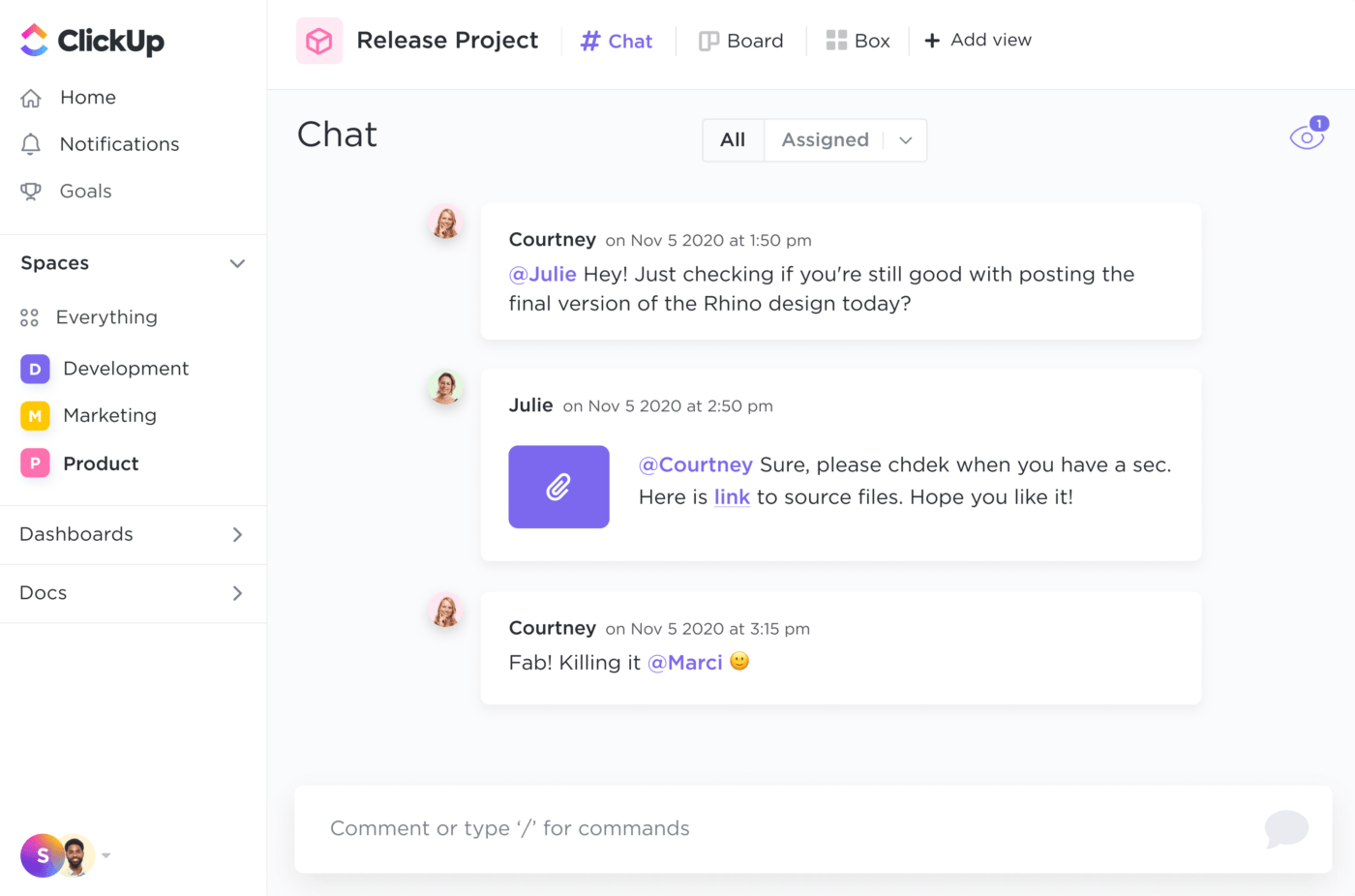
اذكر أعضاء الفريق بعلامة @tag واعترف بجهودهم لتعزيز الثقة
يُعد تقدير ومكافأة أصحاب الأداء المتميزين أحد أفضل الطرق للاحتفاظ بالموظفين وتحسين معنوياتهم.
2. تعزيز فرص التطوير الوظيفي
يجب أن يكون الموظفون الموهوبون لديك قادرين على النظر إلى وظائفهم من منظور أكثر تركيزًا على الهدف. اطرح هذه الأسئلة:
- هل يشعرون بالارتباط بالمؤسسة؟
- ما هو الغرض من وظيفتهم؟
- ما نوع التأثيرات التي تؤثر على قرارهم الوظيفي؟
تكمن الفكرة في تمكين الموظفين من التعبير عن مخاوفهم المهنية والشخصية وتسلق السلم الوظيفي بثقة.
وجود مسار عمل واضح لتقدم الموظف وترقيته يساعد بشكل كبير. التأثير قوالب مراجعة الأداء لتقييم وضع موظفيك وإنشاء خطة تطوير مهني من هناك.
يجب على المدراء إنشاء خارطة طريق مهنية بمساهمة موظفيهم. لهذا الغرض، استخدم ClickUp Whiteboards للعصف الذهني معًا وتخطيط الأفكار للنمو الوظيفي.
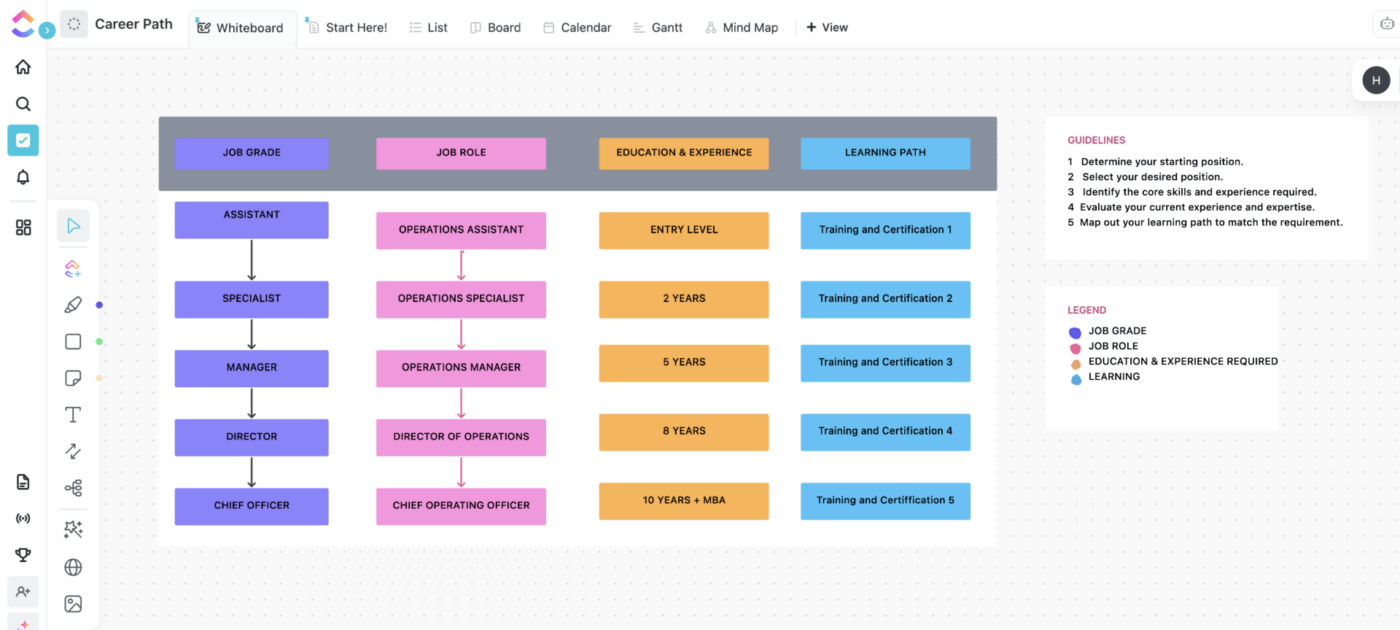
فكر وأنشئ وتعاون مع أعضاء الفريق باستخدام ClickUp Whiteboards
سترتفع معدلات الاحتفاظ بالموظفين لديك إذا رأى موظفوك أن مؤسستك تستثمر في تطوير حياتهم المهنية.
3. اعتماد خيارات عمل مرنة والتركيز على إدارة الضغوطات
الحفاظ على الموظفين عن بُعد منتجين ومشاركين أمر صعب ولكنه ليس مستحيلاً مع وجود الاستراتيجيات الصحيحة في جعبتك:
- العمل المرن: ابدأ بتقديم خيارات عمل مرنة - الطلب الأول للموظفين اليوم. أيضًا، لا تدير العمل بشكل دقيق، وبدلاً من ذلك، عزز المساءلة وثق بفريقك لبذل قصارى جهدهم
- حزم التعويضات المناسبة: أكبر حافز لأي موظف هو الأجر العادل. عند البحث عن الرواتب التنافسية، قم بتضمين مزايا أخرى مثل الرسوم الدراسية المجانية للعائلة، وخدمات رعاية الأطفال، وبرامج دعم مقدمي الرعاية، والتأمين الصحي للوالدين، وما إلى ذلك، وتأكد من أن جداول الأجور ضمن نطاق السوق
- إدارة الإجهاد: قم بالأنشطة والمبادرات التي تسمح للموظفين بالاسترخاء وتعزيز رفاهيتهم؛ قم بالبحث عنأفضل أدوات إدارة المشاريع واختر منصة تتوافق بشكل أفضل مع احتياجات موظفيك. ويمكنهم بعد ذلك ترك العمل الشاق للأداة واستخدام الوقت الذي تم توفيره للعمل على مشاريع الشغف أو تحسين المهارات
4. بناء ثقافة تنظيمية إيجابية
بيئة العمل الإيجابية أمر بالغ الأهمية للاحتفاظ بالمواهب من الدرجة الأولى. وتبدأ بدايات الثقافة المتمحورة حول الموظف بـ:
- مكان عمل شامل للجميع: اجعل تجربة الموظف شاملة ومرحبة. يجب أن يشعروا بالاحترام وأن يزداد شعورهم بالانتماء لقيم المؤسسة؛ كما يجب أن تشعرهم بأن وجهة نظرهم مهمة وأن المؤسسة تدعم رفاهيتهم العقلية والبدنية بكل إخلاص
- الإصغاء النشط: في المناقشات، استمع بفاعلية إلى وجهة نظر الموظف، وكرر ما يُقال، واستخدم لغة الجسد الإيجابية لإظهار الانتباه والاهتمام
- القيادة القوية: ابتكر أسلوب قيادة قائم على التعاطف مع المديرين المستعدين للنظر في المرآة وإجراء تغييرات في المؤسسة حسب الحاجة. فكما يقولون، الموظفون لا يتركون الشركات؛ بل يتركون المدراء السيئين أو ثقافة العمل السامة
- ثقافة داعمة: خلق فرص التعلم أثناء العمل للموظفين للتقدم في مساراتهم المهنية وتقديم الدعم إذا بدا أنهم يعانون. ويمكن أن يشمل ذلك جلسات علاجية، وجلسات فردية مع القيادة، وسياسة الباب المفتوح، وما إلى ذلك. اختر أيضًا أفكار موظفيك على:
- المهارات التي يرغبون في تطويرها
- المجالات التي يعانون منها
- أجزاء من الوظيفة التي يجدونها مجزية أكثر من غيرها
- الأهداف قصيرة وطويلة الأجل
- مقابلات المغادرة: افهم لماذا ترك موظفوك العمل وما الذي كان بإمكانك القيام به بشكل أفضل - مقابلات المغادرة هي بوابتك إلى هذه الأفكار
5. اتخاذ القرارات بناءً على ملاحظات المواهب
افهم كيف تسير مبادراتك الحالية لإدارة المواهب. قم بإجراء مقابلات مع الموظفين للتعرف على السبب الجذري لتعاستهم وأيضًا ما الذي تقوم به المؤسسة بشكل صحيح. استفد من الرؤى التي تم جمعها لإنشاء خطة عمل مستهدفة وبناء مكان عمل أكثر جاذبية.
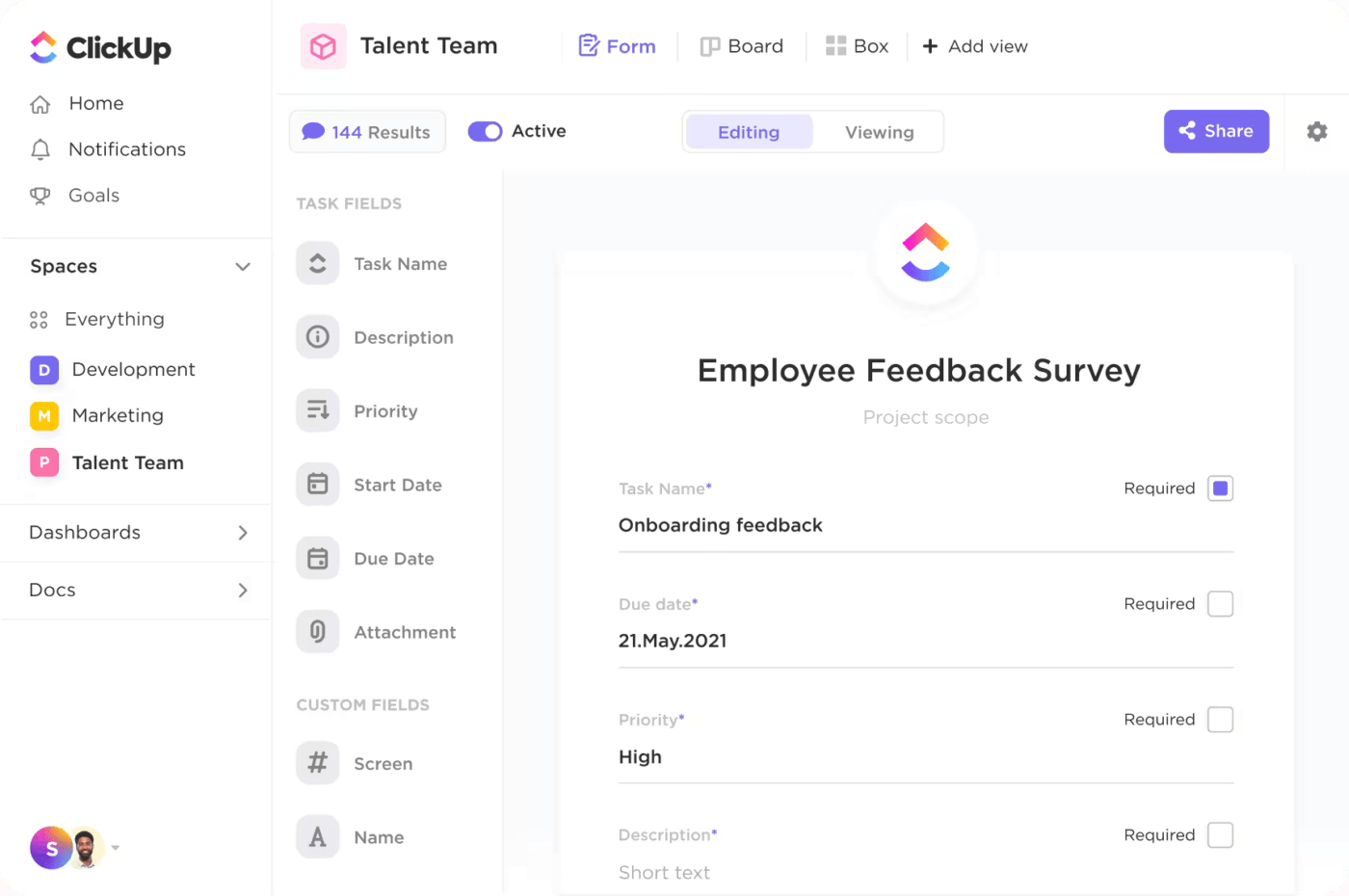
خذ ملاحظات الموظفين لمعرفة كيف يعمل برنامج إدارة المواهب لديك
6. عرض التعاطف
إن تقديم راتب تنافسي هو نقطة انطلاق جيدة، ولكن أصحاب العمل العظماء يعرفون قيمة إظهار التعاطف. فبالنسبة لهم، فإن احتياجات الموظفين تأتي في مقدمة أولوياتهم، ولا يدخرون جهدًا لخلق ثقافة عمل تضع الموظف في المقام الأول. ويمكن أن يشمل ذلك تقديم امتيازات مثل ساعات العمل المرنة والإجازات الطبية مدفوعة الأجر وتعزيز السياسات المتعلقة بالتواصل السريع، واستقلالية أكبر، وغير ذلك.
7. لا تغض الطرف عن معدل دوران الموظفين لديك
أثناء عملك على الاحتفاظ بأفضل المواهب، من المهم أن تراقب معدل الاستنزاف لديك. هناك ثلاثة عوامل رئيسية تساهم في ارتفاع معدل دوران الموظفين - ضعف التعويضات، انخفاض التركيز على إدارة الأفراد، قلة الاحترام. يجب على المؤسسات التركيز على رفاهية الموظفين وبناء علاقات أعمق لتحسين معدل الاستنزاف. تخبرنا مؤسسة جارتنر أن عرض القيمة المتمحور حول الموظف يتضمن خمسة عناصر:
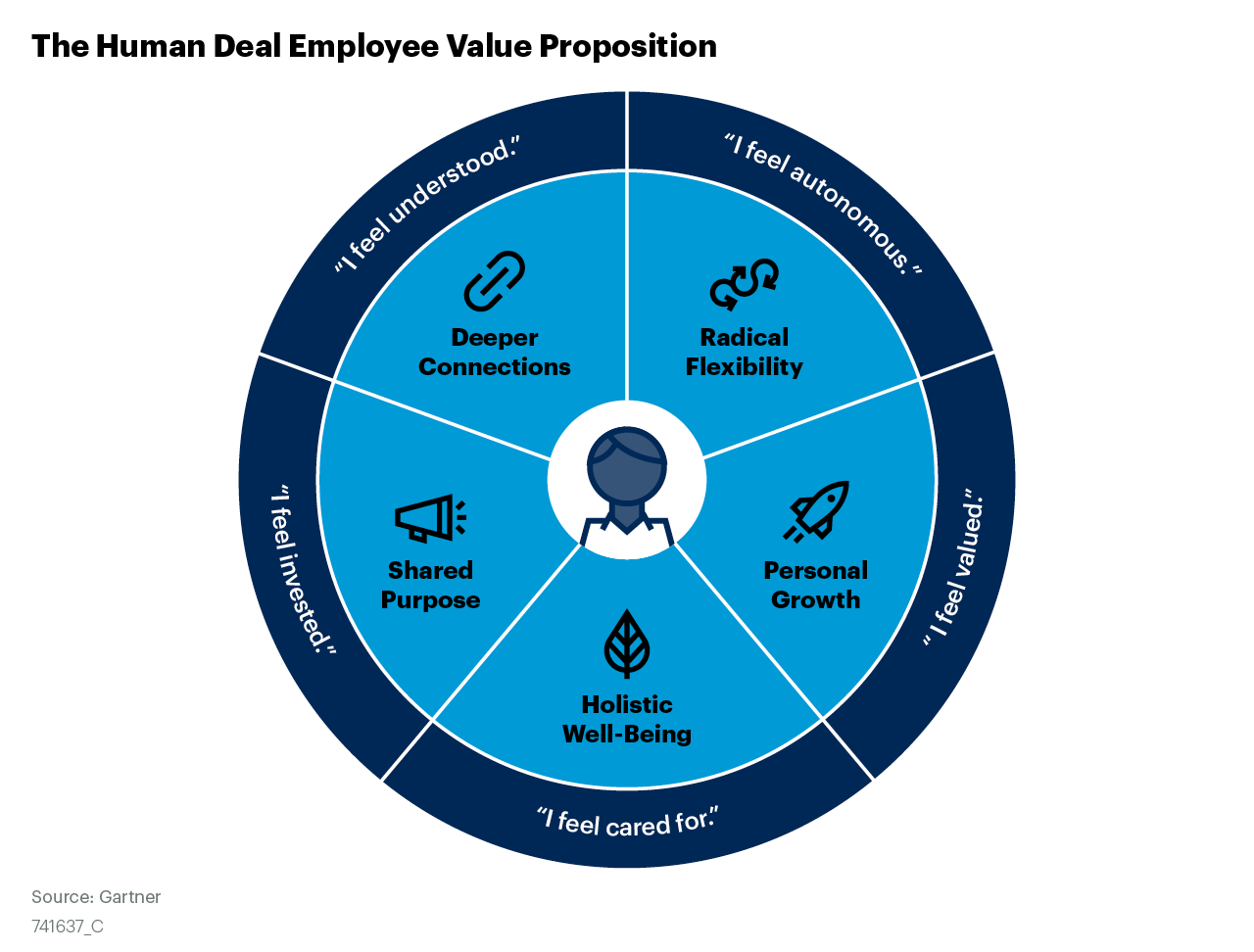
_يجب على القادة أن يسلكوا الطريق الصحيح ويظهروا اهتمامًا حقيقيًا برفاهية الموظفين من خلال
_/ href/ _https://www.gartner.com/en/supply-chain/insights/power-of-the-profession-blog/focusing-on-talent-retention-to-grow-your-organization الشريك //%href/
8. استخدام الأتمتة عند تأهيل الموظفين
يعد تأهيل الموظفين الجدد بشكل جيد أمرًا أساسيًا لتعزيز تجربة الموظف. يجب تهيئة موظفيك لما يمكن توقعه من الشركة قبل اليوم الأول.
هذا هو المكان الذي منصة إدارة الموارد البشرية المتكاملة من ClickUp تساعد المديرين على توفير الوقت وتتيح للموظفين الحصول على فهم أفضل للمؤسسة:

إدارة فريق أحلامك باستخدام برنامج ClickUp للموارد البشرية
في مرحلة التوظيف، يمكن للمديرين إعداد نظام منظم لتخزين بيانات المرشحين الحساسة، وتتبع طلبات التوظيف، وقيادة التواصل. ومن ناحية الموظفين، يجب عليك التأكد من أن تجربة التوظيف لا تتطلب جهداً كبيراً.
يعمل برنامج الموارد البشرية من ClickUp على تنظيم مهام التأهيل ويساعد على نقل المرشحين من خلال خط التوظيف بسرعة.
كما تتيح عملية التأهيل المنهجية المؤتمتة بواسطة ClickUp للمديرين تتبع تجربة الموظفين، والمشاركة والأداء والتطوير - كل ذلك من خلال طرق عرض قابلة للتخصيص في متناول أيديهم. كما يمكن للموظفين الوصول إلى مركز مركزي للمعلومات المتعلقة بالشركة، بما في ذلك سياسات السرية والتعليمات عالية المستوى.
هذا ليس نهاية المطاف. يوفر برنامج الموارد البشرية القوي قوالب الموارد البشرية التي تختصر المزيد من العمل على المديرين والموظفين الجدد. تحدد هذه المستندات المنسقة مسبقًا ما يتوقعه مدير التوظيف من الموظف الجديد، بينما لا يحتاج الأخير إلى إضاعة الوقت في ملء مستندات إدارية لا نهاية لها.
استثمر في تجربة السنة الأولى لجعل موظفيك يشعرون بتقدير المؤسسة لهم وسماعهم - وهي نقطة انطلاق لبناء ولاء طويل الأمد.
اجعل المواهب عالية الجودة في مركز استراتيجية الاحتفاظ بالموظفين لديك دائمًا
يؤكد هذا الدليل على أهمية معرفة كيفية الاحتفاظ بالموظفين ذوي المواهب العالية. يمكن الشعور بفوائد ذلك من خلال استراتيجية الاحتفاظ بالموظفين ومؤشر سعادة الموظفين (إذا كان لدى مؤسستك نسخة موثقة).
فالموظفون الموهوبون الذين يستطيعون أن يكونوا على طبيعتهم هم أكثر سعادة، وأكثر تحفيزًا، وأقل عرضة للاستقالة.
أما من جانب صاحب العمل، فيمكنك ترسيخ انطباع إيجابي في مجال عملك كعلامة تجارية تتمحور حول الموظف - علامة تجارية تقدّر موظفيها وتبذل كل ما في وسعها لرؤيتهم ينجحون.
وبالإضافة إلى ترسيخ ثقافة إيجابية وبيئة عمل متوازنة، يجب عليك تسليح موظفيك بأحدث الأدوات لتخفيف عبء العمل والضغط عليهم - وهو ما يبدو وكأنه وظيفة لأداة متعددة الأغراض مثل ClickUp.
سواء كنت ترغب في تقدير الموظفين، أو الحفاظ على رفاهيتهم الشخصية في المقام الأول، أو مساعدتهم على تخطيط مسارهم الوظيفي بثقة أكبر، فإن أداة إدارة المشاريع المتكاملة مثل ClickUp تتألق في كل مجال. اشترك وانظر بنفسك!
## الأسئلة المتداولة (FAQ)
1. كيف تجذبون أفضل المواهب وتحتفظون بها؟
استخدم هذه النصائح لجذب أفضل المواهب والاحتفاظ بها داخل مؤسستك:
- تقديم تعويضات ومزايا تنافسية من خلال مراجعة معايير الصناعة الحالية بانتظام
- توفير امتيازات إضافية مثل التأمين الصحي، وخدمات رعاية الأطفال، وترتيبات العمل المرنة، وما إلى ذلك.
- بناء ثقافة عمل إيجابية تعطي الأولوية لاحتياجات الموظفين بقدر ما تعطي الأولوية للعملاء
- إطلاق مبادرات لمساعدة الموظفين على الترويح عن أنفسهم، مثل تقديم عضوية في صالة الألعاب الرياضية، وإجراء دروس اليوغا أو التأمل، واصطحاب الفريق إلى معتزل خارج الموقع، وما إلى ذلك
- إعداد فرص تدريبية وتعليمية مخصصة للموظفين لمساعدتهم على النمو في حياتهم المهنية
- تحسين الممارسات القيادية الحالية من خلال تدريب المدراء على التواصل مع الموظفين بصدق، والمشاركة في حل النزاعات بشكل مثمر، وما إلى ذلك
2. كيف يمكنك تحفيز أفضل المواهب والاحتفاظ بها؟ "كيف يمكنك تحفيز أفضل المواهب والاحتفاظ بها؟
فيما يلي بعض الاستراتيجيات حول كيفية تحفيز أفضل المواهب في شركتك والاحتفاظ بها:
- قم بتكريمهم ومكافأتهم علنًا على العمل الذي قاموا به بشكل جيد
- إنشاء برنامج تقدير رسمي لتقدير أفضل الموظفين
- تعزيز المزيد من المبادرات التي ترسي الأساس لتحقيق التوازن بين العمل والحياة الشخصية
- غرس الشعور بالهدف والانتماء داخل الموظف
**3. ماذا يعني الاحتفاظ بأفضل المواهب؟
يشير الاحتفاظ بأفضل المواهب إلى الاستراتيجيات والممارسات الرئيسية التي تستفيد منها المؤسسات للحفاظ على موظفيها الأكثر قيمة والأعلى أداءً من المغادرة.
وينطوي ذلك على تهيئة بيئة يكون فيها الموظفون منخرطين وراضين ومتحمسين للبقاء مع الشركة على المدى الطويل.
ويعتمد نجاح أي مؤسسة على معرفة كيفية الاحتفاظ بالموظفين ذوي المواهب المتميزة، حيث أنهم يجلبون مهارات ومعارف وخبرات كبيرة إلى طاولة العمل. يمكن أن يكون لفقدان هؤلاء الموظفين تأثير سلبي على التوظيف والتدريب والإنتاجية.
